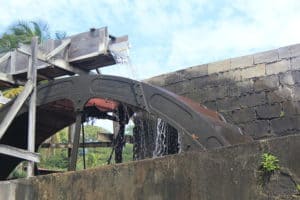About Grenada History
Grenada is located in the Caribbean and is accessible via plane or boat. It’s a country that is just 133 square miles in size. It’s easy to take a drive around the island in just one day.

Grenada History
Christopher Columbus discovered Grenada in 1498. The island was already inhabited by the Carib Indians, who had migrated from the South American mainland, killing, eating or enslaving the peaceful Arawaks who where already inhabitants here. The Amerindians called their island Camerhogue, but Columbus renamed it Concepcion. However, passing Spanish sailors found its lush green hills so evocative of Andalusia that they rejected this name in favor of Granada.
The French then called it La Grenade, and the British followed suit, changing Grenade to Grenada (pronounced Gre-nay-da).
The French, the English and the Caribs
Aggressive defence of the island by the Caribs prevented settlement by Europeans until the 17th century. In 1609 some Englishmen tried and failed. The French spurred on by England’s dismal failure, attempted to colonize the island in 1639; The Caribs booted them out too, but the French soon followed up with a considerably more determined group. A French company founded by Cardinal Richelieu had purchased Grenada from the English The French governor of Martinique, Jaques-Dyel du Parquet, purchased Grenada from the French company in 1649 They established a treaty with the Caribs and bought land in exchange for a few beads and some knives. They built a small settlement and a fort. A general peace initially existed between the Caribs and the French – the Caribs felt the French presence would deter the English from attempting to massacre them as they had done in nearby St. Kitts.
Du Parquet returned to Martinique leaving his cousin Le Comte (governor 1649 – 1654) in charge of Grenada. Hostilities between the Caribs and the French broke out almost immediately as the French endeavoured to extend their control over the whole island. Determined not to submit to French rule, the Caribs fought a succession of losing battles, after several skirmishes with the Caribs, the French brought in reinforcements from Martinique and by 1674 had virtually exterminated the Caribs, some of whom leapt into the sea off a precipice in the north of the island rather than surrender. The French named the spot “Le Morne de Sauteurs,” or “Leapers’ Hill.” A few Caribs lived on in the more remote and inaccessible areas.
The introduction of sugar
The French introduced sugar production and brought in slaves. The island population in 1700 consisted of 251 whites and 525 blacks; the island had 3 sugar plantations and 52 indigo plantations. Grenada was a neglected colony, as it lacked regular communication with France. Administrative regulations ruined the tobacco trade. A busy smuggling trade with the Dutch went on.
The Island stayed in French hands until 1762, apart from an incident in 1675 when the arrival of a group of 100 Dutch privateers surprised everyone and they took control of the island. They themselves were even more surprised by the unexpected arrival of a French Man-o-War shortly thereafter and the French regained control over the island.
Years 1762 – 1958
The French struggled to keep the island from falling into the hands of the British until 1762 when they finally surrendered to a British squadron. On 10 February 1763 Grenada was formally ceded to the British under the Treaty of Paris. When in control, the British soon began the task of Anglicizing the Island, changing the names of places and setting up their own political and religious machinery.
This soon brought tension between the new British settlers and the French inhabitants, who were given the option of either selling their possessions or living within the confines of the new system. The population which remained on the island was granted the right to continue to practice Roman Catholic faith. British governor Melville arrived in 1764; the first island assembly met in 1765. The British crown imposed an extra duty of 4 1/2 % on the Grenadians; the latter sued and the extra duty was abolished in 1774. When the assembly first met in 1765, it was boycotted by the French Roman Catholic settlers. In 1768 the governor appointed two French Roman Catholic permanent members and declared others eligible.
The population of the island
The Island population in 1771 was 1600 whites, in 1777 1300. In 1779 black population 35,000, in 1785 23,926. In 1787 1,115 free people of colour.
On July 2nd 1779 a French fleet of 25 ships of the line, 10 frigates with 5000 men, under the command of Comte d’Estaing retook Grenada. The island force of 90 regular soldiers, 300 militia and 150 sailors surrendered unconditionally, after giving stubborn yet futile resistance. The Comte de Durant was appointed governor. The French took the opportunity to return some of the misdeeds of the English. They also built some large forts, enlarged others and built coastal batteries. All to no avail, as the Island was handed back to the British in 1783 under the Treaty of Versailles, part of the Treaty of Paris which ended the American war of independence.
The returning British Governor, Melville declared St. George island capital (renamed, from Fort Royal). 12 years later in 1795 the Island was once again in turmoil. This time British control was seriously challenged by Julian Fedon, a black planter inspired by the French Revolution. Under Fedon’s leadership, the island’s slaves rose up in a violent rebellion, For 15 months they controlled about 90% of the Island with the exception of the Town of St George with its forts and an outpost at Calvigny. Eventually a large British force attacked from outside and overcame the rebels. Although the rebellion was crushed, tensions remained high until slavery was abolished in 1834. The site of Fedon’s Camp, high up in Grenada’s beautiful central mountains, is today a popular destination for hikers.
During the 18th century, Grenada’s economy underwent an important transition. Like much of the rest of the West Indies it was originally settled to cultivate sugar which was grown on estates using slave labor. But natural disasters paved the way for the introduction of other crops. In 1782, Sir Joseph Banks, the botanical adviser to King George III, introduced nutmeg to Grenada. The island’s soil was ideal for growing the spice and because Grenada was a closer source of spices for Europe than the Dutch East Indies the island assumed a new importance to European traders.
Agricultural changes in Grenada history
The collapse of the sugar estates and the introduction of nutmeg and cocoa encouraged the development of smaller land holdings, and the island developed a land-owning yeoman farmer class. Slavery was outlawed in 1834. In 1833, Grenada became part of the British Windward Islands Administration. The governor of the Windward Islands administered the island for the rest of the colonial period. In 1877 Grenada became a Crown Colony. In 1958, the Windward Islands Administration was dissolved, and Grenada joined the Federation of the West Indies. After that federation collapsed in 1962, the British Government tried to form a small federation out of its remaining dependencies in the Eastern Caribbean.
Following the failure of this second effort, the British and the islands developed the concept of associated statehood. Under the Associated Statehood Act of 1967 Grenada was granted full autonomy over its internal affairs in March 1967. Full independence was granted on February 7, 1974.
1950 – Present
By the 1950’s living conditions of workers led to the formation of the Grenada Manual and Metal Workers’ Union, and in 1951 there was the first Union strike led by Eric Matthew Gairy. Opposing Gairy and his campaign, which some believed to be for personal power disguised by the role of people’s champion, were the planters and the merchants, in addition to workers with reports of intimidation.
The strike formally ended on March 19, 1951, in victory for Gairy’s Union and he and the Agricultural Employers’ Society reached an agreement. Agricultural wages were raised by 50%, and for the workers received paid leave. Gairy’s success thrust him into the limelight and was his rise in political power. He formed the first local political party, the Grenada United Labour Party (GULP) which was pro-independence. In late 1951, the party won a legislative election and Gairy went on to dominate the politics of Grenada for nearly 30 years.
Maurice Bishop and the Coup
There was opposition to separation from Britain, and Gairy, in the form of New Jewel Movement (NJM), formally established March 11, 1973 headed by lawyer and Marxist Maurice Bishop. In January 1974, an ‘anti-independence’ strike broke out preventing Gairy from seizing power. After some weeks of total chaos on the island the paramilitary group, the ‘Mongoose Squad’ through brute force helped secure the situation in Gairy’s favour, and independence was announced the following week on February 7, 1974. Over the following years, Grenada experienced corruption, political intimidation, and increasing unrest On March 13 1979, while Gairy was out of the country, his political opponent Bishop seized power in an almost bloodless coup, due to his widespread local support. They established a provisional revolutionary government, and over the next four years, Bishop set about strengthening ties with nearby Cuba and the Soviet Union. Soon the New Jewel Movement was splitting into factions.
In October, 1983 Bernard Coard, Bishops deputy, former close friend, and NJM hardliner, with backing from the military, overthrew Bishop in a coup d’etat. Bishop and several of his aids were executed. The U.S.A had been concerned about the impact of a communist regime, and this gave them the opportunity to invade. ‘Operation Urgent Fury’ was successful and overthrew the New Jewel regime days later deposing Coard. US forces withdrew two months later, although US-Caribbean force remained stationed on the island for several years after. Democratic elections resumed and in 1984 Herbert Blaize was elected Prime Minister of Grenada.
More recent Grenada history
Despite the island’s long history of British rule, the island’s French heritage (both colonial and revolutionary) survives in the names of places, its buildings, and its strong Catholicism.
The last 20 years have been a peaceful, democratic and fruitful back to normal existence, which has included many new building structures and vastly improved infrastructure. Grenada continues to grow, while still evoking the idyllic lifestyle of the Caribbean of old, which portrayed that rare quality called gracious living.
Grenada is the most southerly of the Windward Islands in the Caribbean,and is a tiny point on most world maps with an area of only 133 square miles. Grenada has a population of about 100,000,and is 21 miles long and 12 miles wide. Grenada has a great deal to offer its visitors in terms of hiking, exploring, sailing, diving and much more. It also has some fascinating history. You can see some of it in our tours.
 English
English 